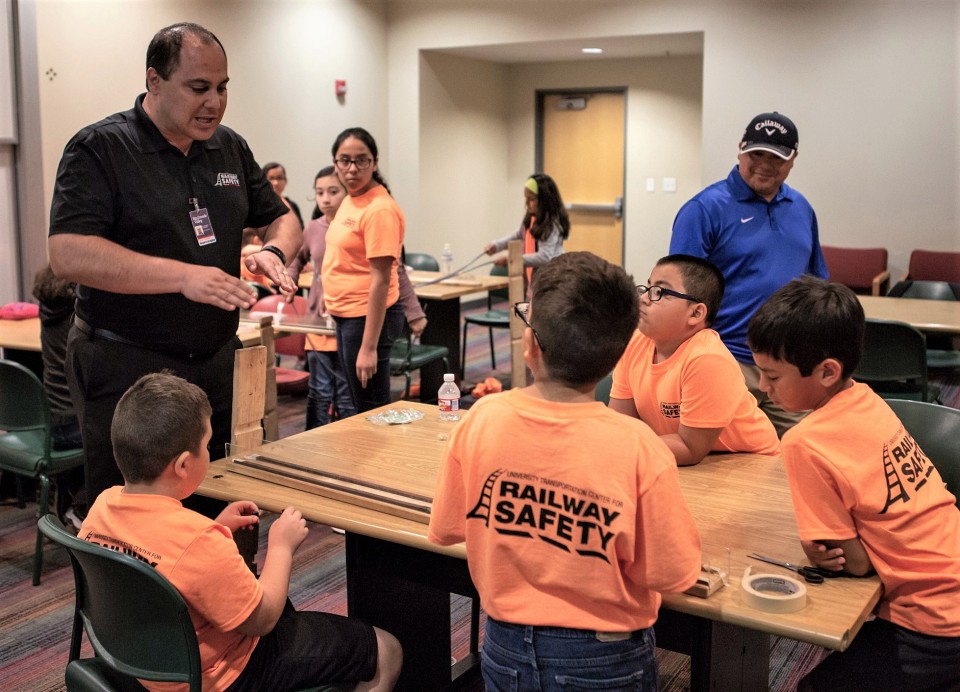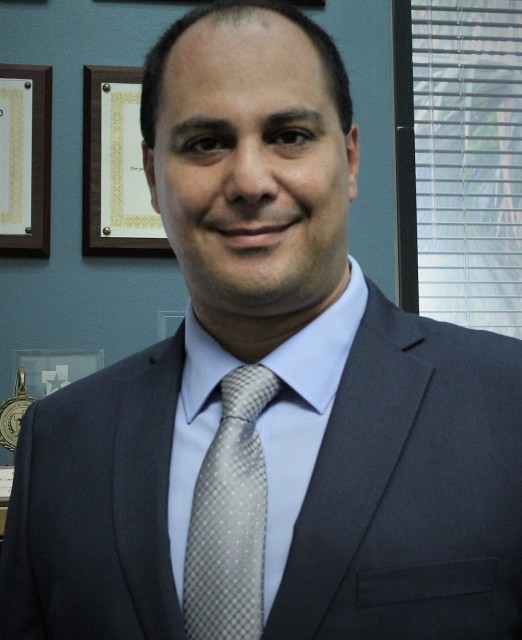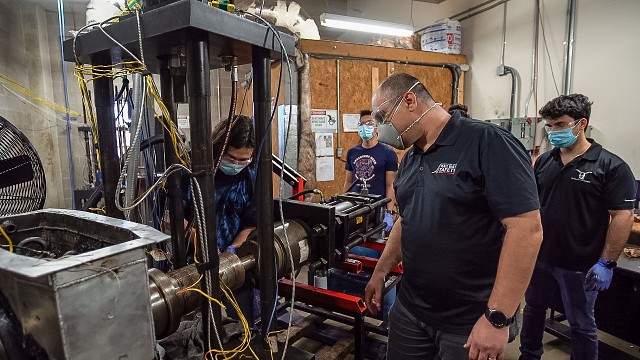By Amanda A. Taylor-Uchoa
RIO GRANDE VALLEY, TEXAS – The U.S. Department of Transportation (USDOT) has awarded UTRGV’s University Transportation Center for Railway Safety (UTCRS) a $10 million grant to focus on promoting safety in railway transportation systems.
Dr. Constantine Tarawneh – senior associate dean of the UTRGV College of Engineering and Computer Science, director of the UTCRS, and principal investigator of the grant – said the funding comes at a critical time for rail transportation, especially in light of recent railway disasters.
“This is the focus of our research at UTRGV,” he said. “Our UTCRS team is made up of faculty and students, and we are concentrating on four primary areas: railway track structure, railway rolling stock, railway grade crossings and developing a Universal Railway Safety Platform.”
Tarawneh in the past few weeks has been referenced in multiple national articles for his participation in railway safety research, and for his research that lead to a patent for a railroad industry improvement invention. He has been cited, or his work has been referenced, in articles from CNN, The Washington Post, Bloomberg News, trains.com, crossroadstoday.com, and Pittsburg Post-Gazette, as well as a segment with Scripps News Morning Rush.
The grant will award $2 million per year over the course of five years, Tarawneh said, with funding starting in the spring through the end of fiscal year 2028. The overall goal of the work is to focus on the safety of railway systems, with secondary goals studying economic strength and global competitiveness, as well as climate and sustainability.
Dr. Janna Arney, UTRGV executive vice president and provost, said Tarawneh has been at the forefront of research in his field and brings his many years of expertise and experiences to the classroom.
“We are so proud of the research Dr. Tarawneh is doing at UTRGV, especially his work on railway safety sensors, and of how passionate he is about sharing that with our students,” Arney said. “They are in the transportation lab with him, researching and developing products that will make a difference in people’s lives and make the world a better, safer place.”
Tarawneh said UTRGV graduate and undergraduate students alike have a chance to engage in state-of-the-art research and development related to railway safety.
The center will support the students financially through employment and tuition remission, which will help them focus on conducting research alongside experienced faculty and staff as they perform application-based railroad research.
"Our students will benefit greatly from proven workforce development that will prepare them to enter the workforce seamlessly,” he said.
FOURFOLD FOCUS
Within the four primary areas of research outlined above – railway track structure, railway rolling stock, railway grade crossings and developing a Universal Railway Safety Platform – UTCRS will focus on the following principles:
- Investigate and develop strategic engineering models of railway components, including track structure, rolling stock, and grade crossings, capable of predicting and avoiding potentially unsafe conditions.
- Identify and investigate railway sensing technologies that increase safety, durability, and life of railway transportation systems.
- Identify and develop sustainable and renewable structural components.
- Identify and develop innovative and practical energy harvesting methods to power the rail infrastructure sensor technologies in development.
- Investigate and develop fully integrated technological software capable of providing straightforward access to both our models and our failure sensing technologies by appropriate railway personnel.
- Train and develop the next generation of rail transportation engineers with emphasis on providing pathways to doctoral programs for underrepresented minorities.
Co-PIs on the UTRGV grant include Dr. Dimah Dera, associate director of UTCRS; Dr. Heinrich Foltz, professor of Electrical and Computer Engineering, UTRGV College of Engineering and Computer Science; Dr. Angela Chapman, Diversity, Equity and Inclusion (DEI) coordinator; Dr. Mohsen Amjadian, assistant professor of Civil Engineering, UTRGV College of Engineering and Computer Science; Dr. Mustapha Rahmaninezhad, assistant professor in practice, UTRGV College of Engineering and Computer Science; and Dr. Arturo Fuentes, professor of Mechanical Engineering, UTRGV College of Engineering and Computer Science.
NATIONAL SPOTLIGHT, COMMUNITY IMPACT
Tarawneh said this grant is the largest STEM grant received at UTRGV, and helps give the university visibility, which in turn helps attract top talent to the faculty.
“Grants like this also help the institution develop much needed doctoral programs in the UTRGV College of Engineering and Computer Science,” he said. “In addition, the work generated from grants of this magnitude will have long-lasting impacts on the rail transportation industry in terms of technology and workforce development, as well as providing the community with engagement programs that can recruit K-12 students to STEM fields.”
Since its inception in 2013, the UTCRS has engaged more than 220 graduate and 600 undergraduate students in its various research, education, workforce development, technology transfer and community engagement activities.
The UTCRS also has hosted about 8,000 K-12 students and 800 STEM teachers in its annual UTCRS STEM Summer Camps.
Tarawneh’s hope is that this grant will help bolster even further student and community involvement in the center.
“We want our students and the Valley community to be proud of the diligent work the UTCRS is doing,” he said. “We want them to see that we are developing and deploying technologies that will mitigate train derailments and enhance highway-rail grade crossing safety, and that we are helping the federal Department of Transportation achieve its vision of Zero Deaths in the transportation system.”
ABOUT UTRGV
The University of Texas Rio Grande Valley (UTRGV) was created by the Texas Legislature in 2013 as the first major public university of the 21st century in Texas. This transformative initiative provided the opportunity to expand educational opportunities in the Rio Grande Valley, including a new School of Medicine and a School of Podiatry, and made it possible for residents of the region to benefit from the Permanent University Fund – a public endowment contributing support to the University of Texas System and other institutions.
UTRGV has campuses and off-campus research and teaching sites throughout the Rio Grande Valley including Brownsville (formerly The University of Texas at Brownsville campus), Edinburg (formerly The University of Texas-Pan American campus), Harlingen, Weslaco, McAllen, Port Isabel, Rio Grande City and South Padre Island. UTRGV, a comprehensive academic institution, enrolled its first class in the fall of 2015; the School of Medicine welcomed its first class in the summer of 2016, and the School of Podiatric Medicine in the fall of 2022.



